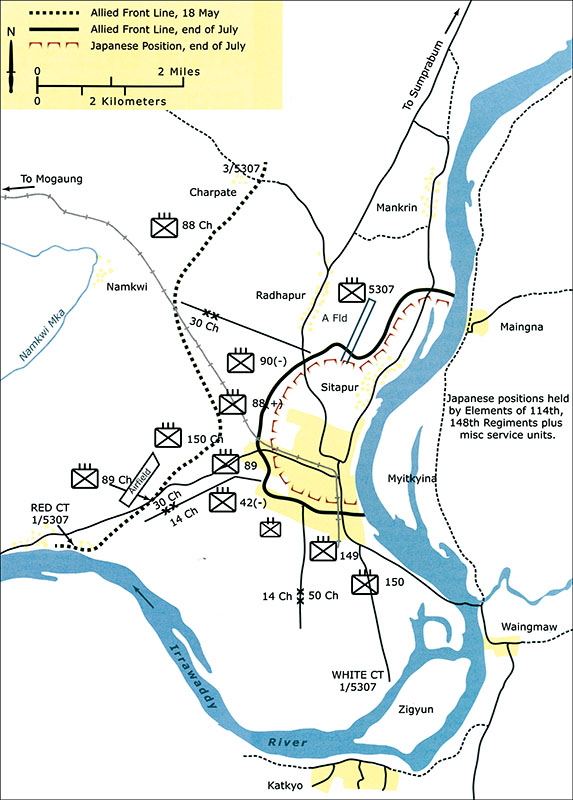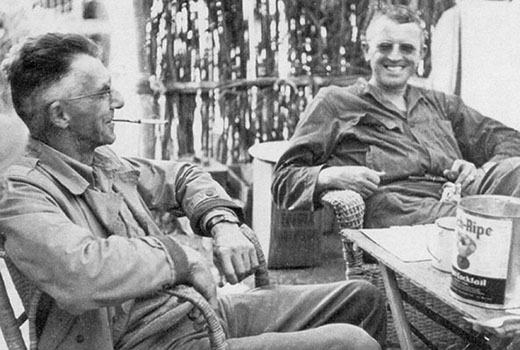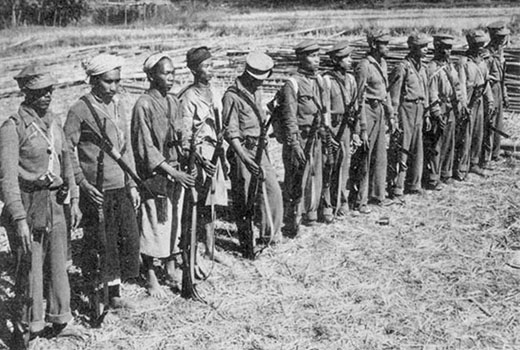SIDEBAR
DOWNLOAD
A critical component of the Allied plan in the China-Burma-India (CBI) Theater focused on the taking of the Burmese town of Myitkyina (Mitch-in-a), whose airfield was considered vital to the continued supply of the Chinese forces supporting the Allied fight against the Japanese. The seizure of Myitkyina would greatly shorten the aerial supply route and free up the use of the Ledo Road, then under construction. With the clearing of the Mogaung Valley in the spring of 1944, General Joseph (“Vinegar Joe”) Stilwell had accomplished half of his campaign plan. The other half was the seizure of Myitkyina. To accomplish this part of the campaign, Stilwell directed that Brigadier General Frank Merrill use his 5307th Composite Unit (Provisional) named Galahad, to spearhead the attack across the rugged Kumon Range. Stilwell called his plan End Run, and it resulted in the end of Galahad as an effective fighting force.1
Galahad, commonly referred to as Merrill’s Marauders, was the United States Army’s first long-range penetration unit in the CBI. First entering combat on 24 February 1944, the original strength of the unit was 2750 men. By April, after virtually continuous combat operations in the brutal jungle conditions of Burma, the three battalions of Galahad were down to 1400 men when the approach march on Myitkyina began on the 28th. By the time Myitkyina fell on 3 August, barely 200 of the original Galahad force remained combat effective, the unit having evaporated in the face of combat losses and disease. The battle of Myitkyina marked the end of the Marauders as the unit disbanded on 10 August 1944.2

Prior to embarking on the movement to Myitkyina, the unit was recovering following the bitter battle around Nphum Ga. The 2nd Battalion in particular suffered heavy casualties when surrounded and isolated for thirteen days—it held on in the face of determined Japanese assaults until relieved. The Galahad force lost fifty-two killed and three hundred-two wounded as well as having three hundred seventy-seven evacuated with various diseases. For the men of Galahad, the fresh food and new clothes they received after the battle could not overcome the fact that the unit was rapidly deteriorating under the strain of near constant combat and illnesses. Malaria, dysentery, mite typhus and the steady erosion of the men’s stamina caused by non-stop marching and fighting on inadequate, airdropped rations drained the force. By the end of April, Galahad was rapidly approaching combat ineffectiveness.3
Despite this, Stilwell was forced to push Galahad into the forefront as the only American unit available to lead the attack on Myitkyina. Under considerable pressure from the Joint Chiefs of Staff to seize Myitkyina before the spring monsoon season, Stilwell could not leave the task to his Chinese regiments alone. He recognized the poor condition of Galahad, but promised Merrill that the unit would be evacuated “if everything worked out as expected.”4

With the thought of relief to sustain them, the Galahad force moved out on the 65-mile march over the crest of the 7,000-foot Kumon Mountains. Merrill divided his forces into three combat teams. H Force under Colonel Charles N. Hunter consisted of the 1st Battalion of Galahad, the 150th Regiment, 50th Chinese Division, the 3rd Company of the Animal Transport Regiment and a battery of the 22nd Division artillery. Colonel Henry L. Kinnison led K Force with the 3rd Battalion of Galahad and the 88th Regiment of the 30th Chinese Division. The M Force under Lieutenant Colonel George A. McGee, Jr consisted of the 2nd Battalion of Galahad and 300 Kachin tribesmen trained by the OSS Detachment 101 under Colonel Ray Peers.5
The unit moved out on 28 April with K Force leading, followed two days later by the H Force. H and K Forces crossed the Kumon via the 6100-foot Naura Hyet Pass, then moved south to the village of Ritpong where the plan called for the columns to diverge and move on Myitkyina by separate routes. M Force moved on a more southerly axis screening the main force as it moved south toward the objective.6
The K Force march over the pass was grueling with twenty of the heavily laden mules slipping and falling off the steep, narrow trail. Approaching Ritpong, Kinnison surrounded the village and the Chinese regiment successfully attacked and overran the Japanese defenses. The village fell on the 9th of April. During this time, H force passed through and headed for Myitkyina. The M Force, hacking its way through dense jungle, repulsed one set of Japanese skirmishers along its route. Despite the loss of half of their mules, M force kept up the pace and stayed within two days march of H and K forces. When a strong Japanese force near the village of Tingkrukawng held up the K Force, Merrill directed H Force to by-pass the fighting and for K Force to break contract and follow. It was during this time that Colonel Kinnison contracted the deadly mite typhus. He was evacuated, but died as a result of the disease.7

The H Force continued to push south and soon reached the outskirts of Myitkyina. On 17 May, Colonel Hunter boldly attacked the airfield located on the northwest side of the town. The Japanese were caught by surprise as the 150th Regiment rushed across the airfield while the Galahad personnel seized the nearby ferry terminal at Pamati. Soon the airfield was under Allied control and the roughly 700 Japanese were bottled up in the town. With the airfield secured, the Galahad force looked forward to their promised evacuation, but unfortunately, it was not to be.
Stilwell determined, for strategic reasons, that he could not pull Galahad out of the line when the airfield fell. The Chinese regiments had sustained heavy casualties in the fighting with few evacuations for illness and needed the presence of American troops to sustain the coalition. Galahad was the only available American unit in the theater. The strength of the Japanese force in the town was growing daily as forces streamed into Myitkyina through the porous Allied lines, further reinforcing Stilwell’s decision to keep Galahad in the fight. The loss of Galahad would have sundered the Allied coalition and led to the loss of the critical airfield.
The battle for the town became a grinding siege with both sides suffering heavily from the constant fighting along the perimeter and the ever-increasing toll of medical problems. By late May, the Second Battalion was down to 12 effectives with the Third battalion little better off. Only the First battalion retained any real strength, about 200 men. Two engineer battalions were pulled off of their duties constructing the Ledo Road and flown in to serve as infantrymen. In early June, 2,500 replacements, the scourings of the units in the rear area in India and returnees from prior Galahad evacuees were flown in to rebuild the force. The “old Galahad” hands were grouped together into the First Battalion and the “new Galahad” arrivals were used to form two new Second and Third Battalions. Throughout the summer the battle to take the town raged on.
The examples of heroism in the fight to take Myitkyina were many. Private Howard T. Smith, his platoon stalled in front of a Japanese bunker and his platoon leader dead, single-handedly assaulted the position and silenced it with grenades. Tech Sergeant Richard E. Roe of the New Galahad force crawled forward and grenaded a Japanese machine gun raking his unit, at the cost of his own life. Private Willard J.D. Lilly and Master Sergeant Charles Ward beat back a Japanese attack with machine gun and rifle fire and saved a platoon from an ambush. Sergeant Fred Coleman of the 236th Engineers threw himself on a Japanese grenade to save two of his comrades. He and the others mentioned received the Distinguished Service Cross or Silver Star for their heroic actions.8


